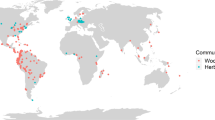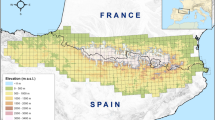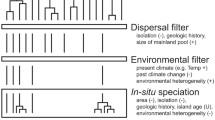Abstract
Although mountainous habitats contribute substantially to global biodiversity, comparatively little is known about biogeographic patterns of distributions of alpine species across multiple mountain ranges. Here, we present a detailed analysis of the distributions and phylogenetic affinities of alpine seed plant lineages across North, Central, and South American mountain systems. Using a large dataset that characterizes the elevational niches of American seed plants in a continuously valued way, we related the proportion of alpine habitat occupied by plant lineages to their biogeographic distributions at a regional scale and place these results in a phylogenetic context. We found alpine species diversity to be greatest in the central Andes and western North America, and that assemblages with lower phylogenetic diversity contained species with a greater degree of alpine specialization. In particular, near-Arctic/boreal alpine communities were characterized by low phylogenetic diversity and higher degrees of alpine specialization, whereas the opposite was observed for southern Patagonian communities. These results suggest that abiotic filtering alone in these climatically similar regions is unlikely to explain alpine community assembly. Nevertheless, the overall relative rarity of alpine specialists, and the tendency for such specialists to be most closely related to montane lineages, suggested that filtering was still an important factor in shaping alpine community structure. This work corroborates the importance of a nuanced and scale-dependent perspective on the ‘history-filtering’ debate axis, as both factors have likely contributed to modern biodiversity patterns observed in alpine plant communities across the Americas.






Similar content being viewed by others
References
Al-Shehbaz IA (2018) A monograph of the South American species of Draba (Brassicaceae). Ann Mo Bot Gard 103(4):463–590
Amini E, Kazempour-Osaloo S, Maassoumi AA, Zare-Maivan H (2019) Phylogeny, biogeography and divergence times of Astragalus section Incani DC. (Fabaceae) inferred from nrDNA ITS and plastid rpl 32 -trn L (UAG) sequences. Nord J Bot. https://doi.org/10.1111/njb.02059
Amiri MS, Joharchi MR, Nadaf M (2020) Ethnobotanical knowledge of Astragalus spp.: the world’s largest genus of vascular plants. Avicenna J Phytomed 10(2):128–142
Antonelli A, Nylander JAA, Persson C, Sanmartín I (2009) Tracing the impact of the Andean uplift on Neotropical plant evolution. Proc Natl Acad Sci 106(24):9749–9754. https://doi.org/10.1073/pnas.0811421106
Antonelli A, Daniel Kissling W, Flantua SGA et al (2018) Geological and climatic influences on mountain biodiversity. Nat Geosci 11:718–725
Bagheri A, Maassoumi AA, Rahiminejad MR et al (2017) Molecular phylogeny and divergence times of Astragalus section Hymenostegis: an analysis of a rapidly diversifying species group in Fabaceae. Sci Rep 7:14033
Barthlott W, Hostert A, Kier G et al (2007) Geographic patterns of vascular plant diversity at continental to global scales (Geographische Muster der Gefäßpflanzenvielfalt im kontinentalen und globalen Maßstab). Erdkunde 61:305–315
Bouchenak-Khelladi Y, Muasya AM, Linder HP (2014) A revised evolutionary history of Poales: origins and diversification: evolutionary History of Poales. Bot J Linn Soc 175:4–16
Brummitt RK (2001) World geographical scheme for recording plant distributions, Ed. 2. Biodiversity Information Standards (TDWG)
Brummitt N, Araújo AC, Harris T (2021) Areas of plant diversity—what do we know? Plants People Planet 3:33–44
Ding W-N, Ree RH, Spicer RA, Xing Y-W (2020) Ancient orogenic and monsoon-driven assembly of the world’s richest temperate alpine flora. Science 369:578–581
Dupin J, Matzke NJ, Särkinen T et al (2017) Bayesian estimation of the global biogeographical history of the Solanaceae. J Biogeogr 44:887–899
Elsen PR, Tingley MW (2015) Global mountain topography and the fate of montane species under climate change. Nat Clim Chang 5:772–776
Fick SE, Hijmans RJ (2017) WorldClim 2: new 1-km spatial resolution climate surfaces for global land areas: new climate surfaces for global land areas. Int J Climatol 37:4302–4315
Flantua SGA, O’Dea A, Onstein RE et al (2019) The flickering connectivity system of the north Andean páramos. J Biogeogr 46:1808–1825
GMBA (2010) The digital Mountain Biodiversity Portal. (https://www.gmba.unibe.ch).
González-Caro S, Duque Á, Feeley KJ, Cabrera E, Phillips J, Ramirez S, Yepes A (2020) The legacy of biogeographic history on the composition and structure of Andean forests. Ecology. https://doi.org/10.1002/ecy.3131
Guo Q, Kelt DA, Sun Z et al (2013) Global variation in elevational diversity patterns. Sci Rep 3:3007
Hughes CE, Atchison GW (2015) The ubiquity of alpine plant radiations: from the Andes to the Hengduan Mountains. New Phytol 207:275–282
Hughes C, Eastwood R (2006) Island radiation on a continental scale: exceptional rates of plant diversification after uplift of the Andes. Proc Natl Acad Sci USA 103:10334–10339
IPBES (2019) Global assessment report of the Intergovernmental Science-Policy Platform on Biodiversity and Ecosystem Services. p 1753
Kelly AE, Goulden ML (2008) Rapid shifts in plant distribution with recent climate change. Proc Natl Acad Sci USA 105:11823–11826
Kier G, Kreft H, Lee TM et al (2009) A global assessment of endemism and species richness across island and mainland regions. Proc Natl Acad Sci USA 106:9322–9327
Körner C (1995) Alpine plant diversity: a global survey and functional interpretations. In: Chapin FS, Körner C (eds) Arctic and Alpine biodiversity: patterns, causes and ecosystem consequences. Springer, Berlin, pp 45–62
Körner C (2003) Alpine plant life: functional plant ecology of high mountain ecosystems, 2nd edn. Springer, Berlin
Körner C (2004) Mountain biodiversity, its causes and function. Ambio Spec No 13:11–17
Körner C, Paulsen J (2004) A world-wide study of high altitude treeline temperatures: study of high altitude treeline temperatures. J Biogeogr 31:713–732
Körner C, Paulsen J, Spehn EM (2011) A definition of mountains and their bioclimatic belts for global comparisons of biodiversity data. Alp Bot 121:73–78
Körner C, Jetz W, Paulsen J et al (2017) A global inventory of mountains for bio-geographical applications. Alp Bot 127:1–15
Kreft H, Jetz W (2007) Global patterns and determinants of vascular plant diversity. Proc Natl Acad Sci USA 104:5925–5930
Luebert F, Weigend M (2014) Phylogenetic insights into Andean plant diversification. Front Ecol Evol 2:27. https://doi.org/10.3389/fevo.2014.00027
Marx HE, Dentant C, Renaud J, Delunel R, Tank DC, Lavergne S (2017) Riders in the sky (islands): using a mega-phylogenetic approach to understand plant species distribution and coexistence at the altitudinal limits of angiosperm plant life. J Biogeogr 44(11):2618–2630. https://doi.org/10.1111/jbi.13073
Marx HE, Richards M, Johnson GM, Tank DC (2019) Increasing phylogenetic stochasticity at high elevations on summits across a remote North American wilderness. Am J Bot 106(7):958–970
McFadden IR, Sandel B, Tsirogiannis C et al (2019) Temperature shapes opposing latitudinal gradients of plant taxonomic and phylogenetic β diversity. Ecol Lett 22:1126–1135
Meyer C, Kreft H, Guralnick R, Jetz W (2015) Global priorities for an effective information basis of biodiversity distributions. Nat Commun 6:8221
Millar C, Fagre DB (2007) Monitoring alpine plants for climate change: The North American GLORIA Project. Mountain Views 1
Moret P, Muriel P, Jaramillo R, Dangles O (2019) Humboldt’s tableau physique revisited. Proc Natl Acad Sci USA 116:12889–12894
Morueta-Holme N, Engemann K, Sandoval-Acuña P et al (2015) Strong upslope shifts in Chimborazo’s vegetation over two centuries since Humboldt. Proc Natl Acad Sci USA 112:12741–12745
Muellner-Riehl AN, Schnitzler J, Kissling WD et al (2019) Origins of global mountain plant biodiversity: testing the “mountain-geobiodiversity hypothesis.” J Biogeogr 46:2826–2838
Myers N, Mittermeier RA, Mittermeier CG et al (2000) Biodiversity hotspots for conservation priorities. Nature 403:853–858
Olmstead RG (2013) Phylogeny and biogeography in Solanaceae, Verbenaceae and Bignoniaceae: a comparison of continental and intercontinental diversification patterns: Solanaceae, Verbenaceae and Bignoniaceae. Bot J Linn Soc 171:80–102
Olmstead RG, Bohs L, Migid HA et al (2008) A molecular phylogeny of the Solanaceae. Taxon 57:1159–1181
Phillips SJ, Dudík M, Schapire RE (2004) A maximum entropy approach to species distribution modeling. In: Proceedings of the twenty-first international conference on machine learning. Association for Computing Machinery, New York. p 83
Phillips SJ, Anderson RP, Schapire RE (2006) Maximum entropy modeling of species geographic distributions. Ecol Model 190:231–259
Picard D, Sempere T, Plantard O (2008) Direction and timing of uplift propagation in the Peruvian Andes deduced from molecular phylogenetics of highland biotaxa. Earth Planet Sci Lett 271(1–4):326–336
Qian H, Ricklefs RE, Thuiller W (2021) Evolutionary assembly of flowering plants into sky islands. Nat Ecol Evolut. https://doi.org/10.1038/s41559-021-01423-1
R Core Team (2020) R: a language and environment for statistical computing. R Foundation for Statistical Computing, Vienna, Austria. URL http://www.R-project.org/
Rahbek C, Borregaard MK, Antonelli A et al (2019a) Building mountain biodiversity: geological and evolutionary processes. Science 365:1114–1119
Rahbek C, Borregaard MK, Colwell RK et al (2019b) Humboldt’s enigma: what causes global patterns of mountain biodiversity? Science 365:1108–1113
Sandel B (2018) Richness-dependence of phylogenetic diversity indices. Ecography 41:837–844
Sklenář P, Balslev H (2005) Superpáramo plant species diversity and phytogeography in Ecuador. Flora-Morphol Distrib Funct Ecol Plants 200(5):416–433
Smith SA, Brown JW (2018) Constructing a broadly inclusive seed plant phylogeny. Am J Bot 105:302–314
Smithers BV, Oldfather MF, Koontz MJ et al (2020) Community turnover by composition and climatic affinity across scales in an alpine system. Am J Bot 107:239–249
Soltis DE, Soltis PS (2016) Mobilizing and integrating big data in studies of spatial and phylogenetic patterns of biodiversity. Plant Divers 38:264–270
Steinbauer MJ, Grytnes J-A, Jurasinski G et al (2018) Accelerated increase in plant species richness on mountain summits is linked to warming. Nature 556:231–234
Swenson NG, Enquist BJ, Pither J et al (2006) The problem and promise of scale dependency in community phylogenetics. Ecology 87:2418–2424
The Angiosperm Phylogeny Group, Chase MW, Christenhusz MJM et al (2016) An update of the Angiosperm Phylogeny Group classification for the orders and families of flowering plants: APG IV. Bot J Linn Soc 181:1–20
Tsirogiannis C, Sandel B (2016) PhyloMeasures: a package for computing phylogenetic biodiversity measures and their statistical moments. Ecography 39:709–714
Tsirogiannis C, Sandel B (2017) PhyloMeasures-package: phylomeasures: fast computations of phylogenetic biodiversity
WCSP (2020) World checklist of selected plant families. Kew. Published on the Internet, Facilitated by the Royal Botanic Gardens
Acknowledgements
H.F., H.E.M., and S.A.S. were funded by NSF DBI 1930030. Additional funding for H.E.M. was provided by NSF FESD 1338694. P.S. and D.S. were funded by NSF 1930007. C.J.G., J.B., and A.S. were funded by NSF DBI 1930005. The authors would like to acknowledge that portions of this research took place on the traditional Territories of the Three Fire Peoples—the Ojibwe, Odawa and Bodéwadmi—as well as others.
Funding
H.F., H.E.M., and S.A.S. were funded by NSF DBI 1930030. Additional funding for H.E.M. was provided by NSF FESD 1338694. P.S. and D.S. were funded by NSF 1930007. C.J.G., J.B., and A.S. were funded by NSF DBI 1930005.
Author information
Authors and Affiliations
Contributions
All authors helped conceive of the study. CJG, and AS wrote the code to assemble the dataset, CJG implemented data aggregation and niche modeling methods, and JB coordinated computational activities. HF, HEM, and SAS developed methods to analyze the dataset and characterize elevational niches. HF and HEM wrote the first draft of the manuscript. All authors contributed to developing methods to aggregate data records and analyze niche models as well as final edits and revisions to the manuscript.
Corresponding author
Ethics declarations
Conflict of interest
The authors declare that there are no conflicts of interest.
Data and code availability
Links to aggregated occurrence records from GBIF and iDigBio, scripts used to analyze species distribution models and calculate climatic niches, CSV files of climatic niches, and species distribution models generated by MaxEnt are deposited with Dryad at (https://doi.org/10.5061/dryad.9cnp5hqgx). This Dryad deposit contains information on ~ 72,000 American seed plants, not just those described here in the main text and supporting information. Species lists for solely the alpine taxa examined here, organized by individual mountains and mountain ranges, are deposited with Dryad at (https://doi.org/10.5061/dryad.4qrfj6q8v), along with associated alpine species taxonomy.
Additional information
Publisher's Note
Springer Nature remains neutral with regard to jurisdictional claims in published maps and institutional affiliations.
Supplementary Information
Below is the link to the electronic supplementary material.
35_2021_261_MOESM1_ESM.docx
Supplementary file1 Additional supporting information in the online version of this article (see Supplementary Material) contains the following: ESM_1—supplementary figures and tables referred to in the main text (DOCX 25511 kb)
35_2021_261_MOESM2_ESM.csv
Supplementary file2 ESM_2—CSV file containing a taxonomy of the angiosperm alpine species included in this study (CSV 188 kb)
35_2021_261_MOESM3_ESM.docx
Supplementary file3 ESM_3—List of likely range-limited endemic Andean alpine species excluded by our data cleaning protocol for building reliable niche models (DOCX 22 kb)
Rights and permissions
About this article
Cite this article
Figueroa, H.F., Marx, H.E., de Souza Cortez, M.B. et al. Contrasting patterns of phylogenetic diversity and alpine specialization across the alpine flora of the American mountain range system. Alp Botany 132, 107–122 (2022). https://doi.org/10.1007/s00035-021-00261-y
Received:
Accepted:
Published:
Issue Date:
DOI: https://doi.org/10.1007/s00035-021-00261-y




